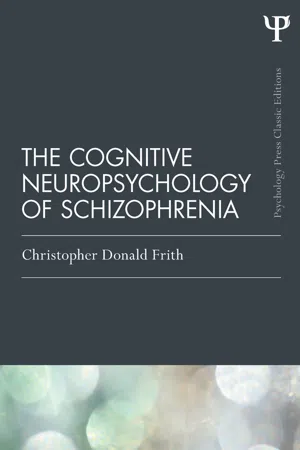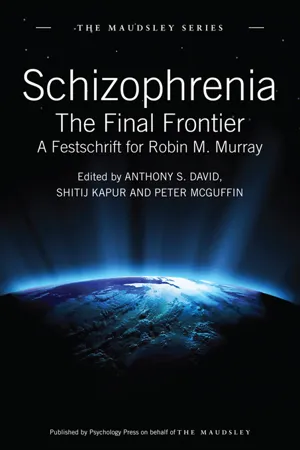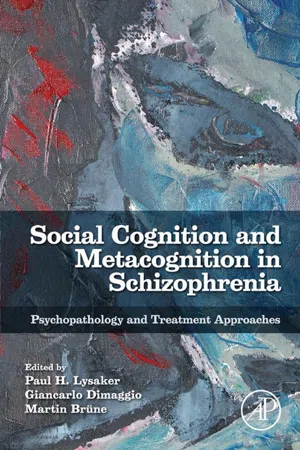Psychology
Cognitive Explanations for Schizophrenia
Cognitive explanations for schizophrenia propose that the disorder is linked to abnormalities in thinking processes, such as attention, memory, and problem-solving. These explanations suggest that individuals with schizophrenia may have difficulties in processing information, interpreting reality, and managing their emotions, leading to the characteristic symptoms of the disorder. Cognitive therapies aim to address these cognitive deficits to improve functioning and reduce symptoms.
Written by Perlego with AI-assistance
7 Key excerpts on "Cognitive Explanations for Schizophrenia"
Learn about this page
Index pages curate the most relevant extracts from our library of academic textbooks. They’ve been created using an in-house natural language model (NLM), each adding context and meaning to key research topics.
- eBook - ePub
- P. J. McKenna, P. J. McKenna(Authors)
- 2013(Publication Date)
- Routledge(Publisher)
9 The cognitive neuropsychology of schizophreniaThe work reviewed in the last chapter culminates in a riddle. How can the abundant evidence of neuropsychological impairment in schizophrenia be translated into a theory of its symptoms, many of which cannot be understood as deficits? Put in a slightly different way, if brain damage causes neuropsychological deficits, why does it not routinely also result in schizophrenic symptoms? One way of solving this riddle is by means of what has become known as the cognitive neuropsychological approach to schizophrenia (Frith, 1992) or cognitive neuropsychiatry (David, 1993; Halligan and David, 2001). The seeds of this approach are in fact contained in the above two questions themselves, both of which are oversimplifications: some symptoms of schizophrenia are deficits, and the gulf between other schizophrenic symptoms and the signs of brain damage may not be as wide as customarily thought.At its most neuropsychological, the cognitive neuropsychological approach simply proposes that certain symptoms of schizophrenia resemble, are perhaps even identical to, particular forms of deficit produced by brain damage. The schizophrenic symptoms concerned are, of course, negative symptoms, and it hardly needs to be stated in light of hypofrontality and some of the other findings discussed in Chapter 5 , that the neurological syndrome is the frontal lobe syndrome and its cognitive counterpart, the dysexecutive syndrome.The most obvious example of brain damage resulting in symptoms that are not simply impairments is fluent dysphasia. Formal thought disorder invites comparison with this, since when it is severe it can give rise to completely incoherent speech accompanied by neologisms. However, the proposal that formal thought disorder is simply a form of dysphasia has more often invited criticism and attack. As a result cognitive neuropsychological approaches have begun to explore other aspects of language such as discourse and pragmatics, or have moved into different areas altogether. The main example of this latter type of approach has once again invoked frontal lobe function, this time arguing that executive impairment is capable of making speech difficult to follow. - Christopher Donald Frith(Author)
- 2015(Publication Date)
- Psychology Press(Publisher)
In this chapter I have proposed a, doubtless over-inclusive, framework for linking the signs and symptoms of schizophrenia to abnormal brain function in terms of a single cognitive process: metarepresentation. I have suggested how specific features of schizophrenia might arise from specific abnormalities in metarepresentation. This is the cognitive mechanism that enables us to be aware of our goals, our intentions, and the intentions of other people. I have also suggested how the brain systems underlying metarepresentation might be studied in man and animals.My theory may be wrong, but I believe that the approach I have used is the most fruitful for understanding the signs and symptoms of schizophrenia. The advantages of this approach are, first, that a framework for understanding the relationships between the various signs and symptoms of schizophrenia is provided. Second, this framework links signs and symptoms with specific cognitive processes. Third, the framework provides criteria for identifying aspects of brain function and animal behaviour relevant to the symptoms of schizophrenia. The framework I have used is, of course, that of cognitive neuropsychology in which specification of cognitive mechanisms provides the crucial link between behaviour, conscious experience, and brain systems.- eBook - ePub
Schizophrenia
The Final Frontier - A Festschrift for Robin M. Murray
- Anthony S. David, Shitij Kapur, Peter McGuffin, Anthony S. David, Shitij Kapur, Peter McGuffin(Authors)
- 2012(Publication Date)
- Psychology Press(Publisher)
2007 ). It is therefore a great pleasure to contribute from a cognitive perspective to this Festschrift to honour the work and career of a giant of research in schizophrenia.Cognitive models share the common proposition that pre-existing beliefs and ongoing appraisals of experiences are crucial for the development and persistence of positive symptoms of psychosis, specifically delusions and hallucinations. In our model, psychosis is considered to be complex and multi-factorial (Fowler, 2000 ; Freeman et al., 2002 ; Garety et al., 2001 , 2007 ). Building on the highly influential work of Robin Murray and others in proposing the neurodevelopmental hypothesis, we adopted the widely accepted proposal that a person who develops psychosis has a premorbid vulnerability of biopsychosocial origin (e.g., Jones, Rodgers, Murray, & Marmot, 1994 ; Murray & Lewis, 1987 ). In the vulnerable individual, stress triggers particular emotional and cognitive changes, resulting in anomalies of conscious experience, for example hallucinatory voices. These anomalous experiences have been linked to information processing and neurobiological disturbances (Frith, 1992 , 2005 ; Gray, Feldon, Rawlins, Hemsley, & Smith, 1991 ; Hemsley, 1993 , 2005 ; Kapur, 2003 ). We further proposed that specific reasoning and information-processing biases, pre-existing schematic beliefs about the self and others, current emotional disturbance and social factors (such as isolation and adversity) both singly and in combination facilitate appraisals of the origins of these anomalous mental states as external. This results in the abnormal beliefs and hallucinations becoming symptomatic. Thus, the experience, for example, of a voice does not necessarily develop into a full-blown psychotic symptom. This only occurs when an individual appraises the voice in particular ways—such as that it comes from an external source, and is personally significant and uncontrollable. It is the particular interpretation or appraisal that causes the associated distress and disability, rather than the experience itself (Chadwick & Birchwood, 1994 ; Morrison & Baker, 2000 ). This emphasis on the role of appraisal is in common with cognitive models of other disorders, such as Beck et al.’s cognitive model of depression (Beck, Rush, Shaw, & Emery, 1979 ). The cognitive model of Garety et al. (2001 ) is represented schematically in Figure 17.1 - eBook - ePub
Social Cognition and Metacognition in Schizophrenia
Psychopathology and Treatment Approaches
- Paul Lysaker, Giancarlo Dimaggio, Martin Brüne(Authors)
- 2014(Publication Date)
- Academic Press(Publisher)
et al . discuss studies in patients with schizophrenia involving the assessment of event-related potentials elicited by social stimuli. The majority of findings they detail strongly suggest that patients with schizophrenia have altered neurophysiologic response patterns in relation to the processing of social stimuli such as facial emotions. Along similar lines, they point to a growing literature on brain imaging in schizophrenia that suggests the presence of aberrant activation patterns during social cognitive task performance, including tasks addressing metacognitive skills. The activation pattern elicited by social cognitive material suggests an involvement of the mirror neuron system. Consistent with this interpretation, there is evidence to suggest that the mirror neuron system is dysfunctional in schizophrenia, as has been shown in several studies that examined imitation of movements and facial expressions, as well as studies utilizing more classic action-observation paradigms.Turning to the issue of sociocultural influences, Kölkebeck and Wilhelm (Chapter 2 ; Cross-Cultural Aspects of Social Cognitive Abilities in Schizophrenia ) explore the question of whether there are cultural differences in processing social information, and whether this should be considered when reflecting on difficulties in social cognition and metacognition among patients with schizophrenia from different cultures. While little work has been done in this area, especially with patients with schizophrenia, Kölkebeck and Wilhelm observe that people in different cultures attend to different elements of social stimuli and attend to those elements in different ways. For instance, cultures that are more individualized, as opposed to more collectivist, direct people to form different types of concepts of self and others. They also discuss research that has revealed differences in brain activation between Caucasian and Japanese individuals when processing social stimuli. Taken together, results orient us to understand that our knowledge of ourselves and others is constructed in social contexts that cannot be ignored and that likely interact with the kinds of neurobiologic factors discussed by Brown et al . (Chapter 1 ; Neurobiologic Underpinnings of Social Cognition and Metacognition in Schizophrenia Spectrum Disorders - eBook - ePub
- JOHN P CUTTING, Anthony David, JOHN P CUTTING, Anthony David(Authors)
- 2019(Publication Date)
- Psychology Press(Publisher)
It is not surprising that different symptom clusters in schizophrenia are associated with different blood flow patterns. Different mental activities provoke different blood flow patterns in normals, of course. Liddle’s results, however, are intriguing because they go some way towards mapping the cerebral dysfunction in different subtypes, though whether they reflect an end-stage cerebral dysfunction or some primary problem is not clear. The patients were all medicated.As mentioned earlier, neuropsychology owes its distinctiveness from the rest of psychology by virtue of its reference to the brain. However, this has led to an obsession with brain localisation. While the location of schizophrenic disturbances to a cortical area would be a valuable achievement, the story would not end there. In fact this would provide but one link in a complete neuropsychology of schizophrenia chain, which would stretch from neural ultrastructure and chemical transmission to the most abstract of phenomenal experiences. Neuropsychology can justifiably regard as its legitimate domain the intervening steps between the abstract levels of representation—hallucinations, delusions, etc. and “pure” psychological phenomena, e.g. memory and attention. No direct reference may be made to the brain provided two underlying assumptions are held, namely, that these psychological processes may become distorted by dysfunction at a lower level—in the brain—and that schizophrenia is the manifestation of just such a distortion. In other words, cognitive psychology may be applied usefully to the study of schizophrenia but some reference to the biological underpinnings to cognition must be made eventually (Fleminger, Chapter 20 ; Bentall, Chapter 19 ; Slade, Chapter 15 ). This is the chief difference between the work done in the 1980s and earlier work. Much of the earlier endeavour may be described as “preneuropsychological” only insofar as neural bases for such phenomena as described by Green and Nuechterlein (Chapter 5 - eBook - ePub
Positive and Negative Symptoms in Psychosis
Description, Research, and Future Directions
- Philip D. Harvey, Elaine Walker, Philip D. Harvey, Elaine Walker(Authors)
- 2013(Publication Date)
- Routledge(Publisher)
The high correlation between Attentional Impairment and reaction time for definite schizophrenics and the predictive power of both of these measures (cf. also, Elliott & Knight, 1982) suggest that for a subset of these definite schizophrenics some deficiency involving attentional processes constitutes a core deficit. The nature of this deficit is far from certain. The specification of an underlying process requires, of course, more than performance on any single laboratory task (cf. Knight, 1984). Moreover, choice reaction time performance involves too many processing levels to yield specific implications (Smith, 1980). For the definite schizophrenics whatever process is slowing reaction time seems also to disrupt attentional behaviors. For the nonschizophrenics some other covariate must be sought.The major implication of these results for our present concerns is that a one-to-one mapping of cognitive processes to manifest thought symptoms is an unlikely prospect. Moreover, the strategy of using simple correlations between laboratory tasks and symptom ratings to search for links between hypothetical processes and symptoms is fraught with pitfalls. The data I have just reviewed suggest that the presence or absence of a correlation is dependent not only on the putative link of the process tapped by the task and the symptom, but also on the typological constitution of the sample tested (Knight et al., 1986) and possibly on the point in the course of the disorder at which the measurements are made (Knight & Roff, 1983). Because of the large number of “saving” or auxiliary hypotheses that can be postulated as explanations for the failure of any particular correlation to reach significance, disconfirmation of a hypothesized process-symptom link becomes problematic (Lakatos, 1970). Alternative research strategies must be devised that revitalize disconfirmation or progress will be stymied.Summary of the Methodological ProblemsIn the above discussion I have attempted to identify and illustrate the core problems that we face when we attempt to relate cognitive processes to symptoms. These include a) the poor operationalization of symptom constructs and the insufficiencies of the nomological network in symptom research, b) the artifactual results in the cognitive domain that can be a by-product of schizophrenics’ general deficiencies in cognitive tasks and might mask the relations of specific deficits to symptom manifestation, and c) the difficulties created by the distinct possibility that the same symptom may be produced by different underlying processes in different patients. I agree with Neale et al. (1985) that research evaluating the relation between laboratory tasks and symptoms is essential, but I doubt that their solution of simply correlating the two measures, even if this is done within subgroups of patients as well as across subgroups, will be sufficient. - eBook - ePub
- Allen Rubin, David W. Springer, Kathi Trawver(Authors)
- 2011(Publication Date)
- Wiley(Publisher)
31 , 189–195.Garety, P. A., & Freeman, D. (1999). Cognitive approaches to delusions: A critical review of theories and evidence. British Journal of Clinical Psychology , 38 , 113–154.Garety, P. A., Freeman, D., Jolley, S., Dunn, G., Bebbington, P. E., Fowler, D. G., Kuipers, E., & Dudley, R. (2005). Reasoning, emotions, and delusional conviction in psychosis. Journal of Abnormal Psychology , 114 (3), 373–384.Garety, P. A.& Hemsley, D. R. (1987). Characteristics of delusional experience. European Archives of Psychiatry and Neurological Science , 236 , 294–298.Gaudiano, B. A. (2005). Cognitive behavior therapies for psychotic disorders: Current empirical status and future directions. Clinical Psychology: Science and Practice , 12 (1), 33–50.Haddock, G., Lobban, F., Hatton, C., & Carson, R. (2004). Cognitive-behavior therapy for people with psychosis and mild intellectual disabilities: A case series. Clinical Psychology & Psychotherapy , 11 (4), 282–298.Haddock, G., McCarron, J., Tarrier, N., & Faragher, E. B. (1999). Scales to measure dimensions of hallucinations and delusions: The psychotic symptom rating scales (PSYRATS). Psychological Medicine , 29 (4), 879–889.Haddock, G., Tarrier, N., Spaulding, W., Yusupoff, L., Kinney, C., & McCarthy, E. (1998). Individual cognitive-behavior therapy in the treatment of hallucinations and delusions: A review. Clinical Psychology Review , 18 (7), 821–38.Haddock, G., Bentall, R. P., & Slade, P. D. (1996). Psychological treatment of auditory hallucinations: Focusing or distraction? In G. Haddock & P.D. Slade (Eds.), Cognitive-Behavioral Interventions with Psychotic Disorders (pp. 45–70). London: Routledge Press.Hole, R. W., Rush, A. J., & Beck, A. T. (1979). A cognitive investigation of schizophrenic delusions. Psychiatry , 42 , 312–319.Jaspers, K. ([1913]/ 1997). General Psychopathology, Volume 1






